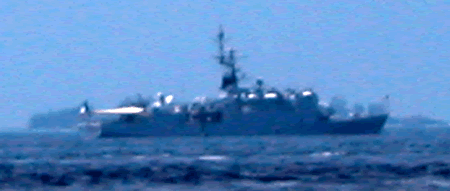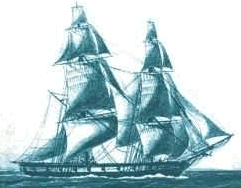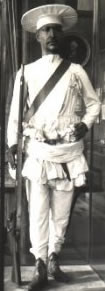 French naval ship off Dhoonidhoo
island: 5 February 2004
French naval ship off Dhoonidhoo
island: 5 February 2004 |
A French naval ship off the island of Dhoonidhoo
is symbolic of the removal of an unwelcome power illegally occupying
Malé. Long may this friendship and symbolism last! (please
click to listen to the national anthem)
When the Maldives received French troops in the 18th
century, France was on the verge of a revolution that gave democracy
to the world.
Liberty
Equality Fraternity
As France prepared itself for democracy, Maldivians
rid themselves of a foreign invader with the help of France.
In the 21st century, Maldivians are on the verge of a
peaceful revolution to achieve democracy. The symbolism is not lost.
Historic relationship
 Joseph-François
Marquis Dupleix. Governor of French India
Joseph-François
Marquis Dupleix. Governor of French India |
Official contact between France and the Maldives
goes back to the reign of the Diyamigily King Siri Navaranna Keerithi
(Sultan Mohamed Imaduddine III al-Mukarram) in AD 1753.
The King was then in custody at the hands of the Ali Raja of Cannanore
at Kavaratti island in the Laccadives. Ali Raja's forces had conquered
the Maldives in 1752 and had abducted the king after installing
an administrator in Malé.
The occupation lasted only four months when Maldive forces led by
an officer of the then disbanded royal militia, Muleegey Dom Hassan
Maniku over-powered and slaughtered the invaders in the dead of
night. Dom Hassan Maniku (later King Siri Kula Ranmeeba Audha Keerithi
Katthiri Bavana also known as Dom Bandaarain) was a direct descendant
of the Hilaaly King Dom João.
 A French paquebot (liner) used from
1783
A French paquebot (liner) used from
1783 |
Dom Hassan Maniku installed a sister of the abducted king as regent
and governed as prime minister until he was proclaimed king in 1759
after the abducted monarch died in custody at the hands of the Ali
Raja.
During the premiership of Muleegey Dom Hassan Maniku, the Ali Raja
repeatedly attempted to re-capture Malé.
In 1753 the Prime Minister sent a delegation led by the minister
Ali Maafaiy Manikfan to meet Ioseph-François Dupleix, Governor
of French India based in Pondicherry.
 A
cipayes (sifain in Divehi and sepoy in English)
in India. The cipayes were native soldiers fighting
under French command
A
cipayes (sifain in Divehi and sepoy in English)
in India. The cipayes were native soldiers fighting
under French command
|
As a result a French squadron was dispatched
under the command of Monsieur Le Termellier to Malé. The
squadron did not take long to defeat the Ali Raja's ships anchored
off the island of Dhoonidhoo near Malé. It then proceeded
to Thiladummati Atoll where a base had been established by the Ali
Raja on the island of Dhonakulhi. The Cannanore invaders were dealt
with a crushing defeat.
The victorious Maldive forces returned to Malé with their
French allies and a pact was signed under which the squadron was
allowed to establish a base at the Naaney Buruzu bastion along the
Malé town wall. The squadron was allowed to fly the French
flag from the bastion and they remained there until recalled by
Dupleix's successor. Until the middle of the 20th century
the narrow lane beside the Naaney Bastion was called Faranji-kaloa
Goalhi (European Lane) in commemoration of the French contribution
to Maldive freedom.
Some of the images
on this page are sourced from pageperso.aol.fr/Book0001/dupen07a.htm.
We thank Jean Druez for providing some of these images and
for kindly guiding us with information relating to them. |
This
web site unequivocally supports |
 |
French
President Jacques Chirac for applying the ban on the
veil. As in the Maldives, the veil is foreign garb in
France. The veil is used as a political statement to
achieve the objective of altering the character of the
French Republic. The French people must resist this
barbaric assault on their culture. Franco-Maldive political
relations go back to the 18th century to
the premiership of the author's grandfather seven times
removed. |
|
| 



 rss feed
rss feed 




